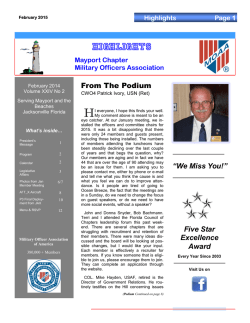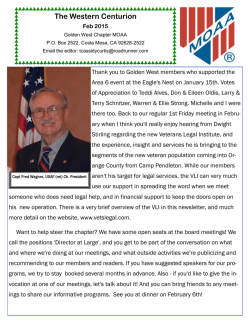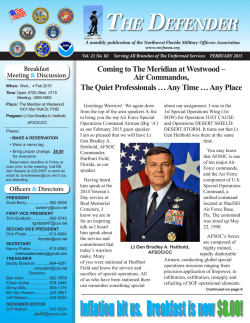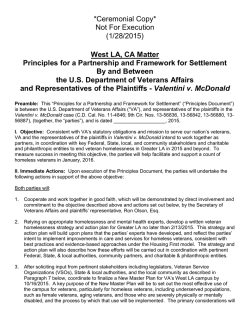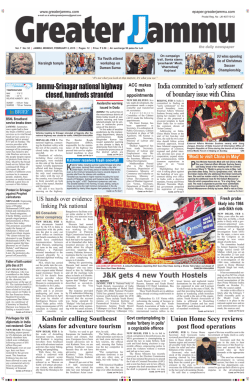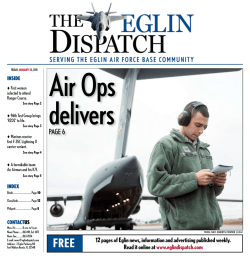
Meet the Historian / Researcher Tim Frank Presenting an Informative
Meet the Historian / Researcher Tim Frank Presenting an Informative Brief on Military Antiques On 18 February 2015 at The Fairfax In This Issue 2 3 4 5 8 9 10 11 The Prez Sez Secretary’s Notes Officers/Directors Chapter Annual Financials Legislative Issues Gate Testing Begins late Jan War Stories A Missed Opportunity Fixed im Frank, professional historian and researcher, is the owner of Military Research Associates LLC. He has been interested in military history and antiques since he was ten years old, after finding his grandfather’s insignia in the attic. His grandfather, Alden Klovdahl, served as an airplane mechanic in the Army Air Corps during the early 1930s and later in the Navy during World War II. Tim’s father his encouraged interest by taking him to the museums in and around Washington, D.C. T In 1994, Frank graduated from St. John’s College High School in Washington D.C., and traveled to Normandy for the 50th anniversary of D-Day. In 1998, Frank earned a BA in history from The Catholic University of America and spent the next year working as a research historian for History Associates, Inc. He went on to earn a MA in history from Kansas State in 2002, and spent the next two years working as a contract historian for The Congressional Medal of Honor Society, where he interviewed 60 Medal of Honor recipients. He worked for a military antiques business from 2004-2006, and then started his own company selling military antiques and researching records at various government archives. From 2010 until January 2015, Frank worked as a historian for the Naval History and Heritage Command, where he interviewed Sailors and spent time on board various ships documenting their history. As a researcher, Tim has spent innumerable hours assisting various writers, including James Cooke’s book Chewing Gum, Candy Bars, and Beer: The Army PX in World War II; Leo Barron’s book, Patton at the Battle of the Bulge: How the General’s Tanks Turned the Tide; and Andrew DeKever’s book, Here Rests in Honored Glory: Life Stories Of Our Country’s Medal of Honor Recipients. Volume 43 Number 2 February 2015 Frank will offer insights into the business of military antiques and offer suggestions on what to do with the items in your attic, i.e., preserve, sell, or donate. He will also have a show-and-tell on a few military artifacts from his own collection of military memorabilia. Frank lives in Silver Spring, Maryland with his wife Clarissa and son Daniel. Page 2 February 2015 The Prez Sez Membership Your membership in The Military Officers Association of America (MOAA) can bring you more than a magazine once a month. It can also give you the opportunity to meet and socialize with other members of the Mt. Vernon Chapter through participation in the monthly dinner meetings, parties and other activities. Of course, many will claim that late hours or going out at night prevent their participation, and that is understandable. Our main concern is that the speakers offer valuable information, insights into legislation or a look at the world of the men and women currently on active duty. Some are not sophisticated speakers, but we often learn a lot from those who have “been there and done that”. Recently there was a letter to the editor in a popular publication in which the writer commented on the great work that is taking place at the individual level in Iraq, an issue that was raised by VADM Ryan when he addressed the chapter in November of last year. The Give Me Ten program is the result of several issues. Obviously, the membership in a militaryoriented organization depends upon the size of the military. A retired military organization has an aging issue as well. Our association, MOAA, and its One Powerful Voice® promotes a strong national defense by lobbying for equitable benefits for those who serve and have served their country in the military; including health care, pay, allowances, and family issues. Many of these benefits are directly the result of legislation. The more members we have, the more strength we have when talking with the government in Washington and in Richmond. In writing this article, I am addressing each form of YOU. When we were on active duty, our chain of command was through military channels, but today in supporting national defense and our hard earned benefits, our chain of command as a citizen is through our elected representatives. It takes individual participation and involvement to make any organization stay alive. Paying your dues helps our functions to continue and your donations help the Mount Vernon Chapter’s scholarship program continue to grow. Taking the time to have a fine meal and gathering with other chapter members helps us to become an extension of the military community we once were a part of and should continue to serve. Being a member of the board of directors, stuffing bags for the USO and attending the personal affairs seminars, are all good uses of your time and energy, but there are many other equally important activities in which chapter members can participate. It is likely you may have other ideas, such as participating in the veterans oral history program conducted by the Library of Congress. Now is the time for you to let the board of directors know your thoughts for continuing the strong showing and meaningful work of the Mount Vernon Chapter. We are currently in need of participation in the personal affairs seminars and community outreach programs such as the Hearts Apart program for families of deployed service personnel, please contact a member of the board if you are interested. All of this is great participation, but the area that is at the top of the MOAA list is legislation at both the national level and within the Commonwealth of Virginia. Before getting into that subject, you are urged to go to the MOAA Website, www.moaa.org, and sign up for the various MOAA online newsletters. Being alerted to any or all of these national issues will let you know about such servicerelated events as the free meal for veterans on Veterans Day but, more importantly, they will keep you up-to-date on legislation and lead you to the website where you can contact your elected officials so items of interest to you will become items of interest to them. Can you imagine what 385,000 messages would say? A tenth of that number gets the Congress to listen. If the membership of MOAA stood united your elected officials would have to take notice. In our recent survey taking care of the active force was a supported issue and adding your voice is how we can do that, so YOU need to do it. Our soldiers in harm’s way would get supported. Our wounded would get the medical support they need. Serving warriors could continue to realize that at the end of their military careers there would be continued support; and through it all their families would truly be a part of this country’s relentless pursuit of freedom for its citizens. Page 3 February 2015 Mount Vernon Chapter Chapter Officers President: CDR Rex Maddox, USN 1st VP: CDR George Wallace, USN 2ndVP: Lt Col Earl Henderson, USAF Secretary: LCDR William Broome, USCG Treasurer: LT Mark Cohen, USN Past President: LCDR William Broome, USCG Standing Committees (2015) 7 03-765-8819 703-354-4647 850-819-3193 703-395-4317 7 03-847-8900 703-395-4317 Directors (2014-2015) COL Russ Henderson, USA LTC Cerie Kimball, USA Mrs. Joyce Davis Aux 703-780-1068 7 03-310-4605 703-360-0748 Directors (2015-2016) COL Bob Patrick, USA LCDR Marty Schaller, USN LT James Ivey, USN 703-690-9336 7 03-323-7339 5 71-499-7738 Arrangements: LCDR Marty Schaller, USN 703-323-7339 Auxiliary: Mrs Joyce Davis 703-372-2564 Despatch Editor: LT James Ivey, USN 571-499-7738 JROTC Awards: COL Arnie Porter, USAF 703-780-4310 Legislative: COL Stuart Williams, USA 703-644-4126 Membership: Lt Col Earl Henderson, USAF 850-819-3193 Personal Affairs: MAJ Nick Sottler, USMC 703-360-9295 Program Admin: Vacant Program Speakers: LTC Cerie Kimball, USA 703-310-4605 Public Affairs: CDR George Wallace, USN 703-354-4647 Scholarship Fund: LCDR Marty Schaller, USN 703-323-7339 TOPS Liaison: Vacant VCOC: COL Robert Patrick, USA 703-690-9336 Veterans Affairs: Vacant Webmaster: LT James Ivey, USN 571-499-7738 Other Duties MOAA Liaison: COL Robert Patrick, USA Chaplain: COL Arnie Porter, USAF Fairfax Liaison: Mrs. Joyce Davis 703-690-9336 703-780-4310 703-372-2564 Secretary’s Notes Reminder ..... Members of MVC/MOAA Board of Directors.... A meeting of the Board of Directors is scheduled for every first Tuesday of the month (except July), at 7:00 P.M. at the South County Government Center 8350 Richmond Hwy. Alexandria, VA (Room 217 or 219). If you are unable to attend, please call Rex Maddox at (703) 765-8819 Email: [email protected]. All members are welcome to attend. Welcome New Members MAJ Robert J. Au Buchon, ARNG Spouse: Michel MVC #3076 Capt Jarvis L. Conic, USMC MVC #3085 Lt Col Jose Harris, USAF Spouse: Maggie MVC #3087 COL Thomas E. Evans, USA Spouse: Joan MVC #3088 Continued on page 4 Page 4 February 2015 Continued from page 3 Current Members Address Changes New Address: CDR Michael A. Zidek, USN (Ret) MVC # 1869 6040 Chapman Road, Mason Neck, VA 22079-4137 (703) 339-8733 MAJ Dennis L. Kellen, USA-Retired MVC #2037 23065 Pecos Ln, Brambleton, VA 20148-7262 (703) 422-7265 LTC Lisa Cramer, USA-Retired MVC #1912 17835 Salado Draw, San Antonio, TX 78258-1602 Change of Phone or Email: CAPT James A. Thur, USN (Ret) LCDR James Brado, USN (Ret) COL Richard Breen, USA-Retired Col Brandy Johnson, USAF (Ret) CW4 Laura Kelly, USA-Retired MVC #2259 MVC #1859 MVC #2144 MVC #2302 MVC #3031 (703) 881-8223 [email protected] (703) 307-3211 (703) 924-6699 (202) 531-6819 Corrections to the January Despatch: New members should read: COL Rupert Murray, USA-Retired - SHOULD READ - COL Murray Rupert, USA-Retired. LtCol Matt Woodfield, USMC – SHOULD READ – LtCol Matt Howard, 5910 Woodfield Estates Dr. Future Dinner Meetings - 2015 On 18 March, we will be at The Fairfax. Our very own COL Russ Henderson along with Dorothy Cantor will tell us about the history of Fort Hunt, Then and Now. Just what is this Fort Hunt in our back yard? Chapter Trivia The Mount Vernon Chapter presently has 334 members - 267 are regular members and 67 are Auxiliary members. The average age is 71, the oldest is 100, and the youngest is 28. Of the 267 officers, 125 are Army; 65 are Navy; 51 are Air Force; 21 are M arines; 4 are Coast Guard; 1 is PHS; there is no one from NOAA. Of the 267 officers, we have 10 - Generals; 2 - Admirals; 92 - Colonels; 32 - USN/CG Captains; 59 Lieutenant Colonels; 22 - Commanders; 15 - Majors; 7 - Lieutenant Commanders; 8 Captains; 4 - USN/CG Lieutenants; 1 - 1st Lieutenant; 2 - USN/CG Lieutenant (Junior Grade); 0 2nd Lieutenants; 0 - USN/CG Ensign; and 13 - Chief Warrant Officers. Page 5 February 2015 Page 6 February 2015 http://optifour.com www.militaryresearchassociates.com The Mount Vernon Chapter thanks its sponsors for their support by supporting them. Please identify yourself as a chapter member when you contact them. www.aalaw.com www.George-Wallace.com www.IndianRiverColonyClub.com/usmilitary Page 7 February 2015 Mail to: [email protected] www.potadv.com www.thefairfaxretirement.com www.merchantcircle.com/business/Fort.Hunt.Service.Center.Inc.703-799-7320 Page 8 February 2015 Legislative Issues Virginia The 2015 Virginia legislative season was kicked off on 14 January with the opening of the General Assembly followed by the Sate of the Commonwealth by the Governor that evening. In his speech the Governor highlighted several areas related to economic growth and workforce development for the Commonwealth. In both of these ares Defense spending and veterans were specifically identified. Regarding Defense spending he stated “When I presented my budget proposal to you last month, I spoke of the impact our sluggish economy has had on state revenues. Virtually all of that drag has been created by federal policy decisions, the most damaging of which is sequestration. Automatic federal budget cuts reduced military contracts in Virginia by $9.8 billion between 2011 and 2013 and, according to a George Mason University study, they threaten to eliminate 154,000 jobs in the commonwealth, or 4 percent of our workforce. And if congress does not act by October 1st, we could be looking at around $50 billion in additional cuts nationwide. That would have a disproportionate effect on our economy, particularly in Northern Virginia and Hampton Roads. Even in the face of these cuts, our close relationship with the Department of Defense and the federal government will continue, and I intend to continue fighting for every dollar we can get.” Regarding veterans and workforce development he stated “I am proud of the work my administration is doing encouraging the hiring of veterans, particularly through the Virginia Values Veterans program. In just over 2 years, the V3 Program’s 234 member companies have hired nearly 7,000 Veterans.” “This session I am proposing to further enhance the V3 program by offering a Performance Grant, which will recognize employers who meet goals for hiring, compensating, and retaining veterans. Additionally, we should ease the transition from military to civilian life by passing legislation requiring the Virginia Community College System to award greater credit for the skills and training veterans receive during their time in the service. These men and women have served and sacrificed for us. Let’s work together to get them the skills, training and economic opportunity that they deserve.” On 15 January the Joint Leadership Council (JLC) representing 23 veterans organizations within Virginia met at the General Assembly Building and the Virginia Capitol to advocate for issues previously identified as important to Virginia’s veterans. Your legislative chair, Col Stu Williams, USA Ret., attended as the MOAA rep to the JLC. During the day we were addressed by numerous speakers. These included Governor McAuliffe, Lt. Gov. Northam, Att. Gen. Herring, Secretary of Defense and Veterans Affairs, Admiral John Harvey, USN Ret., Virginia’s Adjutant General BG Timothy Williams, USA, along with six senators and nine delegates. These included Senate President Pro-tem Stosch, and Speaker of the House Howell. Many of the same speakers also addressed MOAA members of the Virginia Council at the 26 January “Storming” event at the General Assembly. National January 9, 2015 MOAA Legislative Update This year promises to be a difficult one for the military community. Congress will face proposals to overhaul military pay and compensation while sequestration threatens to cut billions out of the FY 2016 defense budget. Below is an estimated time-line of major events in 2015, including the defense bill process, Military Compensation and Retirement Modernization Commission (MCRMC) report, and the return of sequestration: g February 1: The congressionally mandated MCRMC will release its report detailing proposals to overhaul military pay, retirement, and other forms of compensation. The details of the report could become available as early as January 30. g February 2: The president announced he will submit his budget proposal on time to Congress, despite the fact that the MCRMC report will be released at the same time. It’s unclear whether the president’s budget request will include MCRMC recommendations given the narrow time frame. However, the proposal is likely to at least include a third consecutive year of military pay raise caps, dramatic TRICARE fee increases, and other controversial measures. g Mid-March: Six weeks after the president delivers his budget to Congress, congressional committees are required to submit their “views and estimates” of spending and revenues within their respective jurisdictions to the House and Senate Budget Committees. [MOAA Storms the Hill in April] g May-June: The House and Senate Armed Services Committees will begin work on the FY 2016 defense bill. The committees will need to consider recommendations from the MCRMC and how to deal with the specter of sequestration returning in FY 2016. [Virginia Council Congressional Luncheon – 21 May.] Further, an early January note from MOAA’s board of director’s chairman Gen Charles T. Robertson, USAF (Ret) includes a statement of concern: “the nation continues to face the same challenges that we know only too well: global insecurity, competing claims for our national resources, sequestration, and calls to reduce military spending. Now more than ever, we need a strong national defense. Continued on page 9 Page 9 February 2015 Continued from page 8 Unfortunately, the piecemeal reduction of compensation and benefits like we experienced with the FY 2015 defense bill compromise, may jeopardize the recruitment, retention and readiness of our all-volunteer force (AVF) and is doubly worrying since the Military Compensation and Retirement Reform Commission will be offering more comprehensive reform proposals in just a few months. Recent surveys are already highlighting the negative impact on the AVF’s morale. Our strength depends upon our numbers and the resources to work with and educate Congress.” All members of MOAA and the Mt. Vernon Chapter are essential to the effort to mitigate these potential impacts. If not already signed up to receive MOAA periodic updates – please do so by calling MOAA at (800) 234-6622. Automated Installation Entry (AIE) testing at gates begins late January Beginning in late January, and throughout February, Fort Belvoir will be testing the Army’s Automated Installation Entry at Fort Belvoir's gates. AIE is used to enhance security, said Maj. Amber Flores, Directorate of Emergency Services Belvoir police supervisor, and eventually, expedite access to the installation. Department of Defense ID card holders will be directed to one of the AIE pedestals at the gate. “It’s starting out with testing at each of the gates at different times … but, it will eventually be at all of the gates,” said Frank Hentschel, Directorate of Emergency Services director. “All of the lanes will have AIE capability.” Testing at the gates should not have an impact on people coming to the installation, he said. Visitors will be directed to the Visitor Center at the Tulley Gate, where they will be vetted through the FBI’s National Crime Information Center law enforcement files, Flores said. After visitors are registered, they will be able to access the installation by scanning their state driver’s license. AIE scans drivers’ ID cards through the Department of Defense and federal authoritative databases for criminal backgrounds, security alerts or installation debarment. “AIE leverages technology that will increase security for Soldiers, Family members, DOD civilians, retirees, contract employees and guests by verifying the identity of the individual and ensuring they meet Army-approved access standards against FBI criminal and terrorist authoritative databases,” Flores said. “The system automates processes that might otherwise be vulnerable to human error, such as missing expired identification cards or driver access restrictions.” Training begins for gate guards and visitor’s center staff Jan. 23. After the training, testing at all gates begins. “After the training, then we’re going to start turning lanes on,” Hentschel said. “So, there may be two lanes open at the gate and one of the two lanes will say ‘AIE testing in progress, please use both lanes.’ You’ll come up to the AIE where a guard will instruct you how to scan your ID, or maybe the guard will take your CAC or ID card and scan it for you, and we will say this is the new process and this is how it’s done.” AIE prevents piggybacking, or two vehicles going through the gate at the same time, by using a sensor that quickly lifts and lowers the gate arm one vehicle at a time, Flores said. Around 75,000 people access Fort Belvoir each day. When the AIE registers a vehicle with a DOD card holder, it takes 510 seconds for the process, Flores said. After the vehicle is registered, it will take less than three seconds to go through the gate. “The testing will download your information to Fort Belvoir specifically. That way, the next time you go through … and now you know how to do it … you should be ready to breeze right on through,” Hentschel said. During Fort Belvoir’s busiest hours, gate guards will be able to use AIE handheld card readers, doubling the amount of cars going through the gate. One vehicle will access the AIE pedestal, while the second car’s driver will have their card scanned by the gate guard. If both scans are successful, both cars will be allowed to go through the gate. Flores said after the tests, the system will be gradually implemented over the next couple of months. “More information will be disseminated as firm dates and specific changes for procedures are implemented,” Flores said. “We assure you, there will be no drastic changes without proper notification and time to be in compliance.” According to Flores, AIE is currently being tested at 35 locations across the Army. Page 10 February 2015 War Stories CDR Rex Maddox, USN, Ret Airborne Early Warning Squadron Thirteen (VW-13) Pat stayed in Glynco long enough to pin on my wings and to attend the graduation party then we started off to the Naval Air Station, Patuxent River, Maryland and the duty in VW-13. We arrived without event and I was able to visit with my parents and stay with the family for a few days before reporting for duty. I found the squadron located on the northwest side of the base in what had originally been intended to be a seaplane hangar and reported in to the Duty Officer for duty as an airborne Combat Information Center Officer (CICO). My assignment to a crew did not take place right away as I was scheduled for a few training flights with a qualified CICO to ensure I was qualified to take my own crew out on missions. During my time in training, I was called into the Administrative Officer’s office where I was queried as to my intent to attend the coming squadron Officer’s party at the Officers club. This being a good opportunity to meet other officers of the squadron who were in other departments, I gave an affirmative answer to the request and made two reservations. Pat and I made arrangements for a baby sitter (which was no small task as there seemed to be a high demand for sitters on the night of the affair) and drove to the Officers Club which was located several miles from our quarters, on the east side of the base. There was no problem locating the VW-13 party as it seemed everyone we met was going to the event. We found a table for four and sat there for the longest time before anyone approached us for a seat at the table. The young couple turned out to be a new officer and his wife who lived very near to us in Lexington Park. We enjoyed talking with the young couple (he was an Ensign and this was his first duty assignment after finishing school) and I found out he was a navigator who would be assigned to a crew after his qualification. We thought the buffet dinner was somewhat lacking with a poor choice of the available items, but we managed to fill our plates to satisfaction. Following the dinner, there was entertainment with several squadron members and some of the wives doing the honors. I was pleasantly surprised to find the person playing the piano to be Commander Al McPhillips, the officer who had been in charge of the GCA unit at Atsugi, Japan when I had been transferred there from the USS Yorktown and he had notified me of my selection for the Limited Duty Officer and Warrant Officer programs. He, along with several other Commanders, were assigned to the squadron as aircraft commanders, this group included Commander Donald Heberling who had been the Officer in Charge of the Officers Club in Corpus Christi, Texas and with whom we had bowled at that base and become fast friends. My qualification took only two flights with my instructor signing me off to be assigned to a crew. There were no CICO billets available at that time so I was put in a group of qualified officers who were assigned to crews on an “as required” basis. About that time, the squadron received notification of its requirement to perform early warning flights in the straits between the Florida Keys and Cuba. It seems the Cubans had accepted an offer from the Russians to establish several bases from which short and long range missiles could operate. I was assigned to a crew commanded by the squadron Admin Officer and was to have as my CIC crew a group of radar and ECM operators who had never worked together before. We had a training session on the flight to NAS Key West from where we would operate and I found the men on this mission who were to operate the radar equipment were quite competent. We had little opportunity to check the qualifications of the two ECM operators on the flight down to Key West, except with the radars and other emitters we found by flying past US military bases, but there would be an opportunity to listen to other emitters later. Upon our arrival at NAS Key West, the aircraft commander determined I was the person who would make arrangements for the crew billeting and messing. I managed to accomplish this task fairly easily as the base housing Officer was an LDO whom I had known while attending training in Rhode Island. We were assigned to make our first flight two days after our arrival which allowed me time to explore the base and make contact with some old friends. One of these was a former Chief Petty Officer who was in the RATTC at NAS Corpus Christi who had worked for me and whom I had recommended for the Limited Duty Officer program. This individual, Sam Virden, now a Lieutenant Junior Grade, had been assigned to the GCA Unit at NAS Key West as the Officer controller and we had a good time talking over old times. (I was to run into Sam on several occasions after this meeting.) Our first mission watching the coast of Cuba for any possible intruders and the waters of the Atlantic Ocean for any shipping which might be making its way to the port of Havana went without event, the only aircraft we saw were a few commercial planes flying from other islands to Miami and cities north of that in the continental US. Upon returning from this mission we were to have 24 hours before the next opportunity to earn our pay. I took the opportunity to contact Sam Virden and he insisted I have dinner that evening with him, Jean and the girls. We had a pleasant evening discussing our time at NAS Corpus Christi where his girls had gone to school with several of mine and Jean had been on a bowling team that had competed with one in which Pat had been a member. The next mission proved not to be quite as routine as our first. We took off and proceeded to our assigned operating area and had been on station about three hours when I received a call over the intercom (the internal Continued on page 11 Page 11 February 2015 Continued from page 10 communications capability within the radar compartment) from the ECM operator. “Hey, Mr. Maddox”, he said, “I’ve got a signal here that I don’t recognize maybe you’d like to listen to it”. I got up from my radar scope and walked over to the ECM operator’s position where he handed me his headset. Upon putting the headset on, I immediately identified the signal I heard as a fire control radar signal and IT HAD LOCKED ON TO OUR PLANE! I dropped the operator’s headset and ran forward to the cockpit where I told the aircraft commander that we had a fire control radar locked on us. Without hesitation, the pilot put the aircraft into a diving turn, losing about three thousand feet and ending up on a heading to the reverse of the one we had been on. I had to grab onto the co-pilot’s seat to keep from ending up on the flight engineer’s lap and found my radar crew, at least those who were not in their seats with belt fastened, had been thrown all over the CIC compartment by the aircraft commander’s action. The fighter aircraft that had been “on our tail” did not follow us and evidently was satisfied with our maneuver which took us away from the island. I made a written report of the incident but heard no more of the encounter after our landing back at NAS Key West. We made one more mission before the crew was recalled to NAS Pax River. A few days after our return to NAS Patuxent River we were notified by COMNAVAIRLANT (Commander Naval Aircraft Atlantic area) to move the squadron to the Naval Facility at Argentia, Newfoundland. You can imagine the scramble by our mainly senior aircraft commanders who had time in the squadron, to be transferred to other organizations at Patuxent River and not go to Argentia. Many of them were successful and crews were set up with mainly Lieutenant Commanders as the new aircraft commanders. I was assigned to a crew with Lieutenant Commander Ed Henderson as my boss and, with great delight; I found my crew chief to be the recently arrived Senior Chief Joe Shelby. We flew up to ARG (NF Argentia) and set up the squadron in a hangar next to the one VW-11 occupied. There were to be two squadrons of WV’s stationed at Argentia to operate out of NAS Keflavik, Iceland and to provide radar coverage in the Iceland/UK/ Greenland gaps, an operation in support of the cold war. There was no immediate housing available for our families but new quarters were being built and occupation was expected in a month or so. Well, the “or so”, turned out to be several months due to weather delays, etc. In the meantime, I was given leave and returned to NAS Patuxent River where I packed up everything and moved the family to occupy our house in Anaheim, California. Our trip west went off without incident and we enjoyed stopping off at military bases or motels with swimming pools. After getting the family settled in our house, Pat and I drove up to the Lockheed Air Service location in Oxnard, California where one of our aircraft had been for overhaul and installation of new equipment. The aircraft was completed with its servicing and a crew from the squadron had been sent to fly it to Argentia. I joined this crew and made my way back to the squadron, leaving my family in Anaheim until housing was available in Argentia. More on the cold war operations of the squadron and my involvement in another article. A Missed Opportunity Fixed In our January Despatch we included a woodworking story featuring one of our long time Mount Vernon Chapter members Doug Borden. We missed an opportunity to really introduce him to our newer Mount Vernon Chapter members. After twenty-five years of service, including Naval Postgraduate School, the Army War College, six ships, and tours at four different DC-area commands, Doug retired as a Commander in February 1980. Almost immediately he joined what was then TROA, and the MV Chapter. Within two years he was inducted as a member of the Chapter Board of Directors, and has remained actively engaged ever since. He served two years as Chapter President, initiated the Chapter Scholarship program an held several different positions related to that most successful program, and served as Chapter representative to the MOAA Virginia Council of Chapters (VCOC). Still involved, to a lesser extent, he helps represent the Chapter at annual Wreaths Across America ceremonies, has served as a member of the Chapter Audit Board for several years, and attends most monthly chapter dinner meetings. Doug and his wife Joan who are long time Virginia residents moved into Westminister at Lake Ridge in September of 2012. There Doug found kindred woodworking spirits Edward Pearthree and Joe Fleig and the residents of Westminster are fortunate to have their “Westminister Woodworkers.” ST Martin History Club Schedule All events are scheduled for the second Tuesday of month September thru June are you interested? This is your invitation to our dinners. We meet in the Ft Belvoir Officers Club Washington Room(pub) at 6:00 P.M. Then we move to a Dining Room for dinner(steak , salmon or chicken) w/red or white wine of choice. After dinner our speaker will present an interesting and original presentation with our discussion of flight history. We adjourn at 9PM. Please RSVP to me at: [email protected] or, 703590-6508 with your dinner order by the Friday before the dinner. You pay $23. Including tip after dinner. Hope to see you there. Best, Jim Ralph
© Copyright 2024
